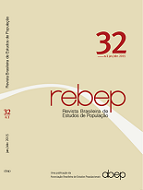Assortative mating patterns of homosexual and heterosexual couples in Brazil
Keywords:
Assortative mating, Homosexuals, Marriage, Education, Family arrangementsAbstract
This paper aims to analyze assortative mating patterns between heterosexual and homosexual couples in Brazil, taking into account parameters such as education, color/race and age group. A descriptive analysis of the data was initially carried out in order to characterize the population studied and the differences between these types of couples. This paper also uses contingency tables and log-linear models to understand the forms of associations between couples and which variables influence mating patterns. The results show that color/race and education have greater influence on the selectivity of heterosexual couples, while color/race and age group are more relevant for homosexual couples when choosing their partners. Thus, it is possible to identify differences in the selective characteristics of these couples as well as different patterns.
These findings pave the way for subsequent studies that can deepen the understanding of the distinctions between these patterns, in order to find ways of trying to explain them and their possible consequences in Brazil.
DOI http://dx.doi.org/10.1590/S0102-30982015000000007
Downloads
Downloads
Published
How to Cite
Issue
Section
License
Papers published in Rebep are original and protected under the Creative Commons attribution-type license (CC-BY). This license allows you to reuse publications in whole or in part for any purpose, free of charge, even for commercial purposes. Any person or institution can copy, distribute or reuse the content, as long as the author and the original source are properly mentioned.

